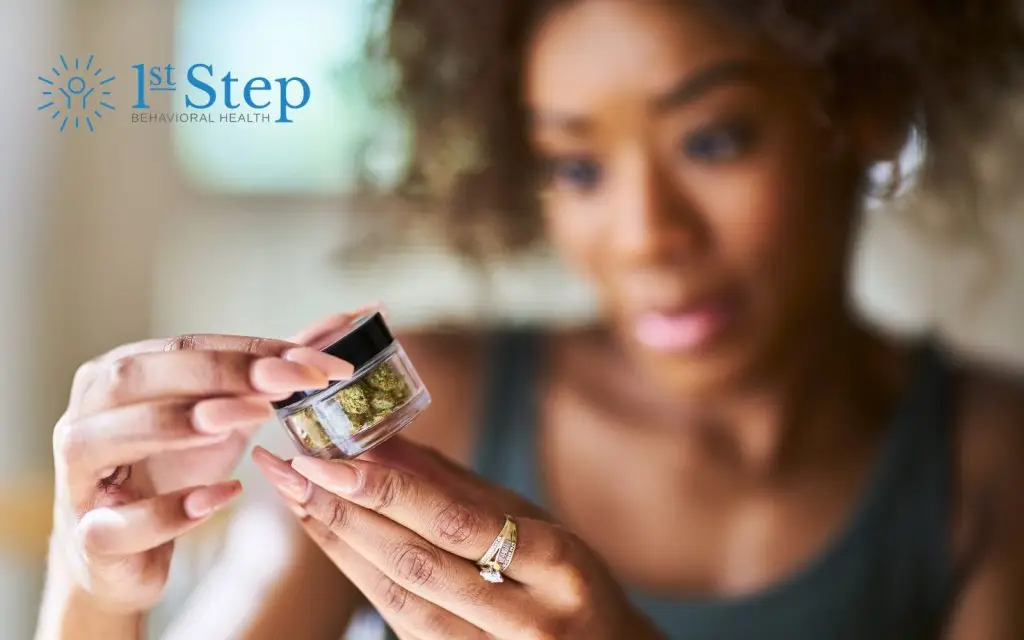Marijuana is one of the most commonly used substances next to alcohol. The National Institute of Drug Abuse states, “Among people aged 12 or older in 2021, 18.7% (or about 52.5 million people) reported using cannabis in the past 12 months.”[1]
Marijuana has been legalized for medicinal and recreational use in some states, so many people assume it is safe for everyday use. However, there are dangers associated with chronic marijuana use.
There are many different forms of marijuana, from flower (weed) and concentrates like wax to edibles and even something called “moon rocks.” If you’ve found yourself wondering, “What are moon rocks?” you’ve come to the right place.
Moon rocks are a type of cannabis flower that is rolled in concentrate and kief, making it highly potent. This means smoking moon rocks could lead to an intense high. Unfortunately, it can also put you at risk of developing THC-induced psychosis.
In this article, you will learn:
- What are moon rocks, and how are they made?
- What are the effects, and how does the moon rock experience feel?
- Can you get addicted to moon rocks?
- How are moon rocks different from cannabis caviar?
- What are the signs of a cannabis use disorder?
- What are the health risks of abusing moon rocks?
What are Moon Rocks and How are They Made?
Moonrocks were made popular by a West Coast rapper, Kurupt. They are a type of cannabis that involves taking a dried bud (or cannabis flower) from the cannabis plant, covering it in concentrate or hash oil, and then rolling it in kief. Kief is a mixture of trichomes and resin that is left behind after someone grinds their cannabis in a grinder. Moon rocks take on the appearance of small white rocks with craters, somewhat resembling the moon, hence their name.
Because of the amount of trichome sand crystals in kief, it is thought to be one of the most potent forms of marijuana. Moon rocks fall in a similar category as concentrates because of their potency. Because of the popularity of cannabis culture, moon rocks are a highly sought-after product in the cannabis market.
While most cannabis flower has a content of 20 to 30% THC, moon rocks sit at about 50%, meaning they are incredibly potent.
People who use moon rocks put them into a glass bowl or bong and smoke them. Sometimes, they are rolled into blunts or joints, but the sticky concentrate can make this difficult.
The Effects and Physical Symptoms of Smoking Moon Rocks
The effects of moon rocks usually begin to kick in a couple of minutes after smoking them. Because this type of marijuana is so potent, it can be difficult to pinpoint exactly how long the effects will last. For some people, the effects fade away after a couple of hours, while others experience a high for more than a day.
Someone with a higher tolerance for THC will experience weaker effects than a person using the substance for the first time.
The effects of smoking moon rocks may include:
- Relaxation
- Euphoria
- Increased appetite
- Feelings of creativity
- Heightened sensory perception
- Lightheadedness or dizziness
- Dry mouth
- Increased heart rate and chest pain
- Dry eyes
- Slower reaction times
- Lack of coordination
While marijuana can cause some people to experience happiness and a calming effect, others may become anxious and paranoid. As a result, it is important that people who try moon rocks already have a tolerance for marijuana because this form of weed is extremely potent.
If you try moon rocks and have a negative experience or a mental health crisis, you should contact a healthcare professional for assistance.
Understanding Substance Abuse: Can You Get Addicted to Marijuana Moon Rocks?
While some recreational dispensaries may sell moon rocks, you can get addicted to them. Just like liquor stores still sell alcohol and pharmacies give out Xanax, you cannot base a substance’s safety on where you are obtaining it.
According to the CDC, nearly 30% of people who use marijuana have a marijuana use disorder.[2]
Moon rocks are more potent than traditional marijuana. If you smoke them frequently, your chances of becoming addicted are higher. Anyone using moon rocks should proceed with caution and be honest with themselves about whether they are developing a habit.
What is the Difference Between Cannabis Caviar and Moon Rocks?
Cannabis caviar and moon rocks are both high-potency cannabis products made by enhancing traditional flower with concentrates, but the key difference lies in their finishing touches. Moon rocks are cannabis buds that are first dipped or coated in a sticky cannabis oil or concentrate and then rolled in a generous layer of kief (the trichome-rich powder). This outer kief coating gives moon rocks their signature dusty appearance and an even higher THC concentration, often making them one of the most potent forms of cannabis available.
Cannabis caviar, on the other hand, skips the kief step. It’s simply a cannabis bud soaked in hash oil or another concentrate, allowing the oil to deeply saturate the flower. The result is a glossy, sticky nug that delivers a strong high, but generally with a slightly lower THC concentration than moon rocks.
Because of the absence of the kief layer, caviar tends to have a smoother, more refined texture and may be easier to handle and smoke for some users. Both products are considered premium and should be used cautiously, especially by those with low tolerance to THC.
Signs of a THC Addiction
The active ingredient in marijuana is known as THC (tetrahydrocannabinol). THC is what causes a high. Whether you are using THC concentrates, edibles, flower, or moon rocks, you can develop an addiction.
If you are worried that you or a loved one is suffering from a THC addiction, look for the following signs:[2]
- Using more THC than you originally intended
- Trying to quit using marijuana but being unable to
- Spending a lot of time using marijuana
- Experiencing strong urges or cravings to use THC
- Using marijuana despite facing problems at work, school, or home
- Continuing to use marijuana despite facing interpersonal relationship issues
- Losing interest in previously enjoyed activities because of marijuana
- Using marijuana in high-risk situations, such as while driving a car
- Continuing to use THC despite experiencing physical or mental health issues
- Needing to increase your dose of marijuana to experience the same high (building a tolerance)
- Experiencing withdrawal symptoms when you do not use THC
If you deal with the above-mentioned signs of a cannabis use disorder, you require professional help. Drug rehab programs can provide you with the support and tools you need to achieve long-term sobriety. Medical detox can help you deal with withdrawal symptoms after quitting the use of cannabis dipped in concentrate.
What are the Health Risks of Using Moon Rocks?
Using moon rocks comes with heightened health risks compared to standard cannabis products due to their extremely high THC concentration—often around 50% or more. One of the most immediate concerns is the potential for severe psychoactive effects, including intense or heightened anxiety, paranoia, hallucinations, or panic attacks, especially in individuals with low tolerance or underlying mental health conditions. The overwhelming potency can also impair judgment, coordination, and reaction time, increasing the risk of accidents and injury.
Long-term or frequent use of moon rocks may contribute to the development of cannabis use disorder, which includes symptoms such as cravings, withdrawal, and loss of control over consumption. Additionally, regular exposure to high THC levels can disrupt memory, concentration, and emotional regulation. Smoking moon rocks—typically done through glass pipes or bongs—also carries the respiratory risks associated with inhaling combusted plant material, such as chronic bronchitis or lung irritation. For individuals predisposed to addiction or mental health challenges, moon rocks pose a particularly high risk and should be approached with extreme caution.
It is important to note that individuals with low THC tolerance are at an increased risk of experiencing negative effects when abusing moon rocks. They are a slow burn, which means you get a lot of effects out of a single session. If you are prone to or have a family history of psychotic disorders, you could develop something known as THC-induced psychosis.[3]
If you are experiencing physical or mental health effects as a result of moon rock abuse, you should seek medical attention. While you can’t die from a THC overdose, you could experience a mental health emergency. Once you are stabilized, it might be time to think about attending addiction treatment.
Find Help for Marijuana Moon Rock Abuse and Addiction
If you or a loved one frequently misuses marijuana moon rocks or another form of cannabis, it’s time to seek help. While marijuana can provide many benefits, it can also cause issues in your life. If your cannabis use is becoming problematic, a professional drug rehab program can help you overcome your addiction.
To learn more about our marijuana addiction treatment programs, contact First Step Behavioral Health today.
FAQ: Moon Rocks and Cannabis Use
1. Are Moon Rocks Legal Everywhere Marijuana is Legal?
Not necessarily. While moon rocks are a form of marijuana, some jurisdictions may restrict the sale or use of high-potency cannabis products. Even in states where marijuana is legal recreationally or medically, specific regulations may limit THC concentration or product types. Always check your local and state laws before purchasing or using moon rocks.
2. How Do Moon Rocks Compare to Other Cannabis Concentrates?
Moon rocks differ from other concentrates in their structure and consumption method. While products like shatter, wax, or oils are pure concentrates typically vaporized or dabbed, moon rocks are a combination product (flower + oil + kief) and are usually smoked. They offer a more intense and prolonged high due to their layered potency.
3. Can Moon Rocks Be Used Medically?
In theory, yes—but with caution. Because of their extremely high THC levels, moon rocks are not typically recommended for medical use unless under very specific circumstances (e.g., severe chronic pain in patients with high THC tolerance). Patients and cannabis consumers should consult with a cannabis-informed physician before using moon rocks for therapeutic reasons.
4. What Should You Know Before Trying Moon Rocks for the First Time?
Beginners should avoid moon rocks due to their high potency. If someone chooses to try them, they should follow these safety tips:
- Be in a safe, comfortable environment
- Stay hydrated
- Avoid driving or operating machinery
- Use a very small amount and wait for the effects before redosing
- Be prepared for intense psychoactive symptoms or adverse effects
5. Do Moon Rocks Cause More Severe Side Effects Than Regular Weed?
Yes, they can. Because of their high THC concentration, moon rocks may intensify negative side effects such as anxiety, paranoia, dizziness, and cognitive impairment. Overconsumption or substance use can lead to what’s known as a “green out”—nausea, confusion, and extreme discomfort. People with mental health conditions should especially avoid high-THC products like moon rocks.
6. How Long Do Moon Rocks Stay in Your System?
THC from moon rocks can stay in your system longer than regular marijuana due to the higher concentration. This can vary depending on metabolism, frequency of use, and method of testing:
- Urine: up to 30+ days for regular users
- Blood: up to 7 days
- Saliva: up to 72 hours
- Hair: up to 90 days
References:
- The National Institute of Drug Abuse (NIDA): What is the scope of cannabis (marijuana) use in the United States
- The Centers for Disease Control and Prevention (CDC): Addiction (Marijuana or Cannabis Use Disorder
- NBC News: High-potency marijuana highlights the risk of cannabis-induced psychiatric disorders
Jump to a Section
Call (855) 425-4846
